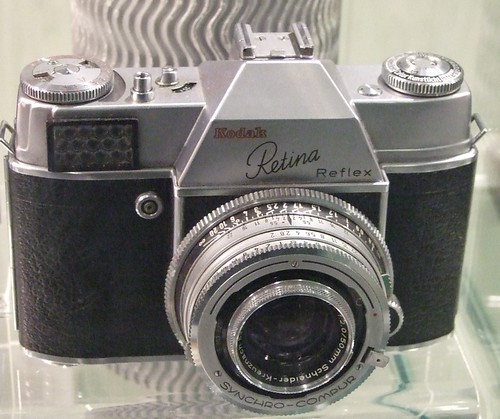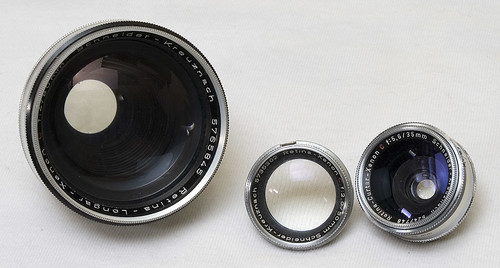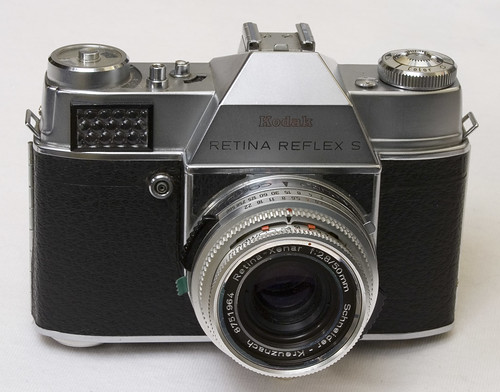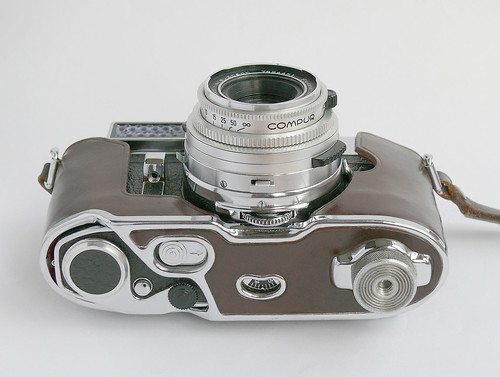Retina Reflex
Contents
- 1 Type 025 Retina Reflex
- 2 Lenses for the Retina Reflex (also for the Retina IIc, IIC, IIc, and IIIC cameras)
- 3 Type 034 Retina Reflex S
- 4 Lenses for Retina Reflex S, II, IV, Instamatic Reflex, Retina IIS, and Retina IIIS
- 5 Type 041 Retina Reflex III
- 6 Type 051 Retina Reflex IV
- 7 References
- 8 Sources
- 9 Links
Type 025 Retina Reflex

|
| The original Retina Reflex |
The Kodak Type 025 Retina Reflex is a 35mm SLR camera produced by Kodak AG Stuttgart in West Germany, between the spring of 1957 and October 1958. It was sold with either the Schneider Xenon C or the less common Rodenstock Heligon C 50mm f2 lens. This was Kodak's response to the quite successful range of leaf shuttered Zeiss Ikon Contaflex cameras introduced in 1953. By doing so, Kodak expanded their Retina range to include SLR cameras.
The Retina Reflex body is based on the Retina IIIc, and they share the same range of lenses with an interchangeable front component, which can also be used on the Retina IIc, IIC, and the IIIC rangefinder cameras. Also the base mounted advance-lever, the frame-counter, the film channel, the selenium meter, and the lens focusing mechanism, are very similar to those on the viewfinder camera, while the Synchro-Compur shutter is of the SLR variety, which stays open prior to releasing the shutter.
The camera lens is a converter-based system, consisting of a fixed rear group and a bayonet mounted interchangeable front-component, the latter determines the compound focal length. This concept was introduced in 1954 with the Kodak Retina IIIc. The focusing mechanism moves the rear lens group and the Synchro-Compur shutter with the integral diaphragm together. A similar interchangeable component system was introduced on the Zeiss-Ikon Contaflex III in 1956.
Three very similar accessory lens components were available, manufactured by both Schneider and Rodenstock; the 80mm and two alternative 35mm components. The Schneider and the Rodenstock front components are not interchangeable though, and they do not share the same bayonet mount, they only fit the camera equipped with either manufacturers own original standard lens. Care must be exercised using the accessory lens components, since the aperture control is not limited to these lenses' maximum aperture of either f/4 or f/5.6, but rather stops at f/2
The Retina Reflex camera has an automatic lens diaphragm that stays wide open until the shutter is released. After exposure, the mirror stays up until the bottom-mounted single-stroke advance lever is operated. Focusing is on a ground glass screen with a central split-image rangefinder.
Most camera controls, except the wind-on lever, are found on the top plate. The manually set frame counter, which locks the camera at the end of the film, has a reset-button in its centre, and a slide-button to turn the dial at the camera back. Also the shutter release, the film rewind knob with a film reminder dial, the exposure readout window, the meter adjustment knob with EV and ASA/DIN scales, and the accessory shoe are at the top. The tripod socket, the advance-lever, the film-rewind release-button, and the tiny back-latch release-button, found under a twist-cover, are all at the camera base.
In use, the Retina Reflex frame counter counts down from 36 (or 20) to 0, at which point the film advance locks. While this is convenient for the user and does prevent torn film sprockets at the end of a roll, setting the counter up properly at the beginning of a roll is complex, awkward, and time consuming. This is a typical example of much of the Retina engineering - complex and ingenious, but not always convenient.
The non-coupled selenium cell exposure meter shows exposure values (EV) only. The value is set on the EV scale found on the underside of the lens assembly. Once the aperture release tab is set and released, the shutter ring is interconnected with the aperture ring - the one automatically moves the other, so that the same exposure value is maintained. This was a quite common arrangement, found on many cameras at the time, like Hasselblad and some Rolleiflexes. It may be a bit confusing to those unfamiliar with the system.
All the Retina Reflex cameras are quite complex instruments and heavy, but still reasonably reliable, although the lever wind mechanism tends to wear out. The repair is considered complex and many repairmen refuses to work on them. It is however, usually possible to repair the mechanism without spare parts for a handy repairman.
The Retina Reflex originally sold for $215 USD[1] (app. $1570 USD in 2007). Approximately 65,000 were made.
Lenses for the Retina Reflex (also for the Retina IIc, IIC, IIc, and IIIC cameras)

|
| Schneider interchangeable front components
80mm f/4, 50mm f/2, and 35mm f/5.6 |
The Retina Reflex can be fitted with 4 different lenses. They all share a common set of three elements at the rear of the lens.
- Schneider-Kreuznach Retina-Xenon C 50mm f/2 (3+3 elements in 4 groups)
- Schneider-Kreuznach Retina-Longar-Xenon C 80mm f/4 (6+3 elements in 6 groups)
- Schneider-Kreuznach Retina-Curtar-Xenon C 35mm f/4
- Schneider-Kreuznach Retina-Curtar-Xenon C 35mm f/5.6 (6+3 elements in 6 groups)
or
- Rodenstock Retina-Heligon C 50mm f/2
- Rodenstock Retina-Longar-Heligon C 80mm f/4
- Rodenstock Retina-Curtar-Heligon C 35mm f/4
- Rodenstock Retina-Curtar-Heligon C 35mm f/5.6
Type 034 Retina Reflex S

|
| The Retina Reflex S with Schneider Xenar 50m f/2.8 lens |
Introduced in 1959, the Type 034 Retina Reflex S was a major redesign of the original Retina Reflex. The major difference is its use of fully interchangeable lenses, the same lenses that were made for the Kodak Retina IIIS rangefinder camera. The lens mount is commonly referred to as the Deckel mount, after the manufacturer of the Prontor, Compur and other shutters. This same mount, with minor differences, was also used by a number of other German camera makers, including Braun and Voigtländer. It was also used in the later Retina Reflex III, Retina Reflex IV , and the Kodak Instamatic Reflex. As for the original Retina Reflex, lenses were available from both Schneider and Rodenstock, but this time the lenses had identical bayonet mounts.
The shutter is a Synchro-Compur behind the lens unit, which is part of the camera body. The aperture is now in the interchangeable lenses, which eliminates the overexposure problem of the original Retina Reflex. Speed are from 1 sec. to 1/500th plus bulb. It features M and X syncs and a self-timer.
What was the meter adjustment knob on the top plate is now a fixed housing for the ASA/DIN scale. The selenium cell exposure meter is now coupled to a "setting wheel" located on the very bottom of the lens mount. This setting wheel sets adjusts the camera's exposure value (EV) by changing (in a most complex fashion) the aperture and/or shutter rings at the same time that it changes the depth-of-field pointers on the camera's lens. When another button (located on the top plate) is pushed simultaneously, the setting wheel is also used to set the exposure meter's ASA/DIN setting.
This remarkable bit of engineering demonstrates the complexity of the Retina Reflexes, which makes them a joy to use when they are working, which they seldom are. Their complexity and fragility also make most repairmen reluctant to touch them.
The top plate, bottom plate, and camera body are otherwise nearly identical to the Retina Reflex.
The Retina Reflex S originally sold for $235 USD[1] (app. $1670 USD in 2007). Approximately 78,000 were made.
Lenses for Retina Reflex S, II, IV, Instamatic Reflex, Retina IIS, and Retina IIIS
- Schneider-Kreuznach Retina-Curtagon 28mm f/4
- Rodenstock Retina-Eurygon 30mm f/2.8
- Rodenstock Retina-Eurygon 35m f/4
- Schneider-Kreuznach Retina-Curtagon 38mm f/2.8
- Schneider-Kreuznach Retina-Xenar 45mm f/2.8 (sources are unclear on this lens)
- Rodenstock Retina-Ysarex 50mm f/2.8
- Schneider-Kreuznach Retina-Xenar 50mm f/2.8
- Rodenstock Retina-Ysarex 50mm f/1.9
- Schneider-Kreuznach Retina-Xenon 50mm f/1.9
- Rodenstock Retina-Rotelar 85mm f/4
- Schneider-Kreuznach Retina-Tele-Arton 85mm f/4
- Schneider-Kreuznach Retina-Tele-Arton 90mm f/4
- Rodenstock Retina-Rotelar 135mm f/4
- Schneider-Kreuznach Retina-Tele-Xenar 135mm f/4
- Schneider-Kreuznach Retina-Tele-Xenar 200mm f/4.8
Type 041 Retina Reflex III

|
A later variant is the Type 041 Retina Reflex III. It was made from 1960 to 1964.
Its match-needle meter instrument scale is visible in the viewfinder as well as on the top plate. The camera was originally equipped with the same coupled selenium meter as the Reflex S, but after 1962 a larger one was fitted, again made by Gossen. The Reflex III features the same "setting wheel" and interlocking aperture/shutter rings as the Reflex S. As it was fashion in the early 1960s the shutter release button on top was replaced by a shutter release shifter beside the lens mount. The film advance release button was eliminated, that function being incorporated in the frame reset slider, which was moved to the bottom plate along with the (still) manually reset frame counter. The ASA setting button was moved from the ASA dial to the spot vacated by the release button.
This redesign made a new camera case design necessary, leaving additional space for the frame counter, and the frame reset slider. The Retina Reflex cases were already something special before since the film advance lever (Reflex) and aperture/shutter setting wheel (Reflex S) are located on the bottom. The photo shows just how complex the Retina case had become.
The Reflex III features the same aperture/shutter setting wheel (which Kodak called simply the "setting wheel") and interlocking aperture/shutter rings as the Reflex S.
The Retina Reflex III originally sold for $248.50 USD[1] (app. $1720 USD in 2007). Approximately 116,000 were made.

|
Type 051 Retina Reflex IV
The Type 051 Retina Reflex IV was made from 1964 to 1967. It has a characteristic little window in the front of its pentaprism housing, which displays the aperture in use in the viewfinder. A hot shoe replaced the accessory shoe of the Reflex III. The frame counter now automatically resets to 36 when the back is opened; the frame advance slider is used to set the counter for shorter rolls. The split-image rangefinder on the ground glass is now at a 45 degree angle.
The Retina Reflex IV originally sold for $277 USD[1] (app. $1860 USD in 2007). Over 524,000 were made.
References
Sources
- Brian Coe, Kodak Cameras - The First Hundred Years, Hove Foto Books, 1988
- Rudolf Kingslake, A History of the Photographic Lens, Academic Press, 1989
- Original Kodak user manuals for the Retina Reflex, Retina Reflex S, and Retina Reflex IV
Links

|
| Some photo amateurs know tricks to use the fine lenses of the Bessamatic |
- Retina Reflex III, Retina Reflex, Retina Reflex S, Retina Reflex IV on www.collection-appareils.fr by Sylvain Halgand
- German article in Schneider-Kreuznach archive
- Retina Reflex section at Retrography.com by Simon Simonsen, Denmark
- Retina Reflex III and IV at Westford.com
- Retina Reflex at "Photography"
- insight into a Retina Reflex of 1958 at "Innovative cameras"
- History of Kodak Cameras at Kodak's website